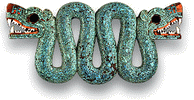San Lorenzo
Category: OlmecThe first and most ancient capital of Indian America is San Lorenzo (1400-900 years. BC). It is situated on a natural plateau, the slopes of which were modified to create numerous residential terraces. According to archaeologists, it lived up to 5 thousand people. The city is still patronized the almighty god of the jaguar. His masks were decorated with the corners of the steps of the pyramid (the oldest known in America today), which is a cone with a diameter at the base of about 130 m, but with an incorrect projection. Of the pyramid are drawn two mound, between which lies a stone mosaic floor in the form of a jaguar snouts. Also in the city were built: the first playground for ball games, and stone drainage systems and stone sculpture.
Between 1150 and 900 AD. BC San Lorenzo turned into a broad settlement, which occupied the summit and slopes of a low plateau. Its area is defined differently: 52.9 ha, 300 ha, and even 690 hectares (the latter figure is clearly exaggerated).
Archaeological investigations in the valley. Coatzacoalcos revealed a three-tiered settlement hierarchy. The first level is represented by San Lorenzo. Second level (type 6 in the classification project of San Lorenzo) – a settlement with a terrace and an area of 25 hectares. They number four (San Antonio, Auatepec, Loma del Zapote, and an unnamed settlement by the hill of Pena Blanca), and they are located on high ground about the same distance from each other. The third level are numerous villages and isolated households.
Buildings found on the site in 1990-ies., Situated on low, not exceeding 2 m platforms. The most important of these was the so-called “Red Palace”. It was a big long building with walls made of rammed earth and limestone and sandstone slabs. Under the floor there was an aqueduct from basalt troughs. Judging from the analysis of soils, the roof, “the palace was made of palm leaves. A central pillar for the roof, basalt columns. Another important building (D4-7), 12 m long and apsidal in plan, standing on a platform of clay sizes 75 to 50 m.
In the city was found 10 of the Olmec colossal heads of basalt, as well as altars, thrones, and dozens of anthropomorphic and zoomorphic sculptures. Colossal head, obviously portrayed paramount chiefs. Their small number and concentration in the central settlement is additional evidence in favor of it. Although the heads are not individual portraits, but they differ from each other. In addition, each head has its own special hat. It is known that in Mesoamerica headdress was the main indicator of status. These ten goals from San Lorenzo, probably represent the ten generations of the dynasty that ruled in the valley. Coatzacoalcos for 250 years (1150-900 BC.). In smaller quantities of the monuments were discovered in the surrounding settlements. However, the colossal heads are found only in San Lorenzo, and in settlements in the second level are only altar-thrones (eg, Potrero Nuevo) and statues of seated men with signs of high status (necklaces, earrings) in complex headdresses. Finds of the electrons in the settlements of the second level, thus, suggest the existence of a hierarchy of leaders.
About 900 BC. ends renaissance of San Lorenzo. This is offered as historical (conquest, social struggle) and natural (volcanic activity, changes in river channel) explanations. However, the center has not been abandoned (phase Nakaste, 900-700 bc). It is to middle formative phase is monumental architecture – earthen hills and platforms, located around the area. The study of settlements around also shows that the decline was only relative. Settlement hierarchy still consisted of three levels: 1) San Lorenzo, 2) settlement with a terrace, an area of 25 hectares and several earthen mounds, platforms, and 3) a small village with no monumental architecture. Centers of the second level in some cases changed their location. In general, the number of settlements in the immediate district of San Lorenzo has decreased, and at the periphery increased. All of this suggests that a complex chiefdom of San Lorenzo, although it has undergone a certain crisis, remained unchanged.
By 400 BC San Lorenzo is in decline, after which the city is abandoned.


